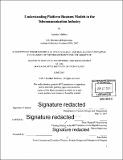| dc.contributor.advisor | Marshall Van Alstyne. | en_US |
| dc.contributor.author | Melchor, Jonathan | en_US |
| dc.contributor.other | System Design and Management Program. | en_US |
| dc.date.accessioned | 2017-10-30T15:29:57Z | |
| dc.date.available | 2017-10-30T15:29:57Z | |
| dc.date.copyright | 2017 | en_US |
| dc.date.issued | 2017 | en_US |
| dc.identifier.uri | http://hdl.handle.net/1721.1/112065 | |
| dc.description | Thesis: S.M. in Engineering and Management, Massachusetts Institute of Technology, School of Engineering, System Design and Management Program, 2017. | en_US |
| dc.description | Cataloged from PDF version of thesis. | en_US |
| dc.description | Includes bibliographical references (pages 85-92). | en_US |
| dc.description.abstract | Telecommunication (telecom) companies face increasingly tough times as digitization reshapes the industrial landscape. In 2012, telecom companies acknowledged that over-the-top (OTT) communication services have become the greatest threat to their revenues. OTT communication services use the internet to deliver an array of services such as voice, video calls, and messaging. Some of the most popular OTT companies are Skype, WhatsApp, WeChat, Google Hangouts, Viber, Line, etc. The continued business disruption is driving telecom companies to investigate platform-based business models as key ingredients to survival. Platform business models are the core of some of the most powerful and fastest-growing companies such as Alibaba, Uber, Airbnb, Facebook, etc. Platform businesses bring together producers and users in efficient exchanges of value. These models are known for leveraging network effects, which means the more participants on the platform, the greater the value produced. With the appearance of the 5th generation (5G) of mobile network connectivity, telecom companies need to know how they can protect themselves from being delegated by disruptors as commodity connectivity providers. In this thesis, we explored the areas where 5G can have an impact in the next five years. We used a technique developed by Professor Marshall Van Alstyne. The technique consists of plotting an interaction's perceived value versus interaction volume then selecting the area with the highest interaction of perceived value and volume. Results showed that immersive media has these characteristics. After we identified the area, we selected a platform using the concept evaluation methodology. The most feasible multi-sided platform (MSP) for the telecom industry in the next five years is a 3600 HD video platform with live and recorded long-tail content (large number of unique items with relatively small quantities). The MSP consists of four sides: users, content developers, advertisers, and software developers. Platform launch, monetization, openness and network effects strategies are proposed. Moreover, a financial analysis was performed. Results show the proposed MSP is a feasible option. Finally, a stakeholder analysis compares an existing digital platform versus our proposed platform. Results show similar behavior. | en_US |
| dc.description.statementofresponsibility | by Jonathan Melchor. | en_US |
| dc.format.extent | 107 pages | en_US |
| dc.language.iso | eng | en_US |
| dc.publisher | Massachusetts Institute of Technology | en_US |
| dc.rights | MIT theses are protected by copyright. They may be viewed, downloaded, or printed from this source but further reproduction or distribution in any format is prohibited without written permission. | en_US |
| dc.rights.uri | http://dspace.mit.edu/handle/1721.1/7582 | en_US |
| dc.subject | Engineering and Management Program. | en_US |
| dc.subject | System Design and Management Program. | en_US |
| dc.title | Understanding platform business models in the telecommunication industry | en_US |
| dc.type | Thesis | en_US |
| dc.description.degree | S.M. in Engineering and Management | en_US |
| dc.contributor.department | Massachusetts Institute of Technology. Engineering and Management Program | en_US |
| dc.contributor.department | System Design and Management Program. | en_US |
| dc.identifier.oclc | 1006732502 | en_US |

